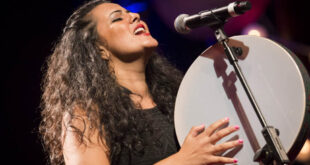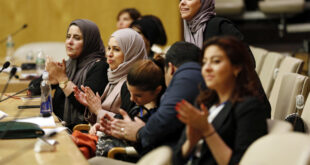The recent profusion of graphic televised footage of dead bodies, sometimes charred or disfigured, has raised difficult ethical and journalistic decisions for news editors, whether at CNN or the Hizbullah-backed Lebanese channel Al-Manar. In a series of interviews, news editors talk about their decision-making policies on screening disturbing images.
The coverage of the four US civilian contractors whose bodies were mutilated after a roadside attack in the Iraqi town of Fallujah in late March clearly illustrates the different approaches taken by the channels.
Chris Cramer, managing director of CNN International, said the images that came into the news room from Fallujah varied from long shots to close-ups.
"We made a judgment that this was a bit of a watershed in violence against Westerners in Iraq ... and therefore it was acceptable to include images which I think, if they had occurred in other stories in other parts of the world, we might not have included," he said. "You need to afford people dignity in death ... and we thought it was inappropriate to show close-ups of corpses which were burned."
CNN was, however, one of the few channels to show the bodies hung up on a bridge, an editorial decision Cramer said was justified by the uniqueness of the event. "There is no textbook for this stuff. It was an occasion where, with the appropriate care, we needed to show what we showed."
There was no difference in the use of footage between CNN and CNN International. "Where we tend to do things slightly differently, if we believe on the domestic channel that there are clearly relatives and next of kin in the US, then we would always wait until next of kin are informed," he said.
In stark contrast to CNN, the BBC only aired the event once, on the 10pm evening news, for three seconds in a long distance shot. "This was heavily prefaced with a warning," a BBC spokesperson said.
Jihad Ballout, media relations spokesperson for the Qatar-based satellite network Al Jazeera, said the editorial committee took a different route "by not showing the mutilated corpses being dragged by kids or hung from bridges.
"We showed footage indicative and reflective enough ... the burning and stoning of the car and a long shot of a charred corpse. We described what happened and felt that the description was strong enough," he said. "The jubilation of the crowd was more reflective of the mood than the hanging on the bridge."
Elie Harb, assistant editor in chief of the Lebanese Broadcasting Company (LBC), said the channel showed only five or six seconds of graphic images. "There is too much detail on people killed in Iraq, whether American or Iraqi," he said.
Hassan Fadlallah, news editor at the Lebanon-based, Hizbullah-backed channel Al-Manar, said they did not use all the images available of the dead contractors. "We only showed a little bit, because it is against the ethics and morals of our religion, and of Al-Manar's policy. We believe there is a certain sanctity of the human body."
"We try not to show dead soldiers' bodies in detail, using long shots rather than in close focus, so as to not hurt the feelings of the soldier's family," Fadlallah added.
Cultural differences have been highlighted by media commentators as an explanation for the difference in the usage of graphic footage between Western and Arabic TV news.
"I think there are some cultural differences; I think there are clearly some editorial differences," said Cramer of CNN. "There are networks around the world that believe if you edit coverage then you are censoring, which I think is completely risible. Our newspapers and TV channels would be full of blood and gore and nothing else."
"We have a responsibility to report the world and to live without fear or favor and not just shy away from unpalatable images," Cramer added. "At the same time, you have a responsibility not to confront the audience with a bloodbath ... To edit is to choose."
Harb, of LBC, said the decision to show graphic images on the news was based more on culture than politics. "We in the East are not shocked if we see bodies, we are used to seeing bodies from war," he said.
Harb explained how restrictions on the usage of footage often come from outside Lebanon, citing the example of when two Japanese civilians were killed in Iraq and LBC aired the images. "We received a call from the Japanese Embassy (in Beirut) telling us to please not show images of dead bodies. I asked why, and he said you are offending our viewers in Japan ... If we receive calls from outside saying the images are shocking, we will not show them."
Harb said that, ironically, the most shocking footage LBC aired was of the bodies of Saddam Hussein's sons. "The situation was very strange ... when they (the US military) permitted all the film crews to enter, it was a small tent with two bodies. You had to shoot close ups ... of disgusting, un-humanitarian shots. We were obliged to show them ... There are always exceptions."
Fadlallah said, "We have certain morals and ethics and this differs from what the Americans might use ... Sometimes we feel that we have to show such pictures or footage to make the case much clearer."
Asked whether the difference between Arabic and Western news was cultural, Fadlallah said it was both cultural and ideological. "Regarding culture, our policy is not to show such images to children. Sometimes we have to show such images to make the story clearer to the viewer, such as of the full footage of (slain Hamas leader Abdel-Aziz) Rantissi's assassination. Rantissi's family allowed us to show this footage. Sometimes we show our footage live, like operations that take place in Israel, usually straight from Israeli TV. Some violence might pass."
All those interviewed commented that the decision to air graphic images or not was complex and challenging. "These are tough decisions and none of us have the right answers everyday. It is a fascinating debate, but it is a debate. It is not a science," said Cramer.
 Arab Media & Society The Arab Media Hub
Arab Media & Society The Arab Media Hub




